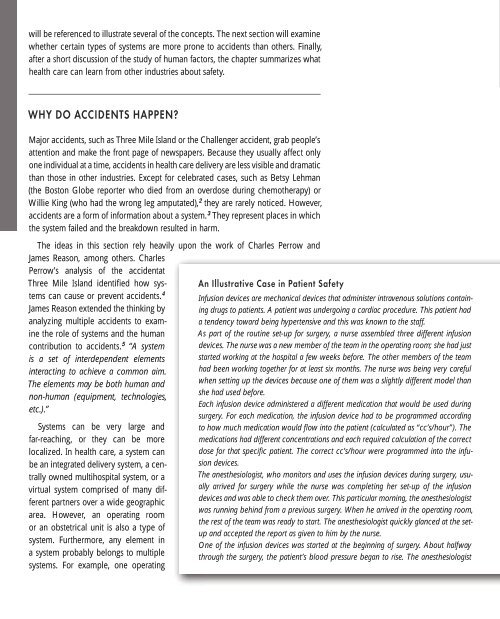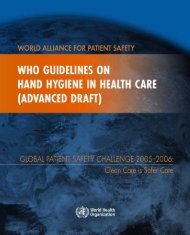Adverse event reporting.pdf
Adverse event reporting.pdf
Adverse event reporting.pdf
Create successful ePaper yourself
Turn your PDF publications into a flip-book with our unique Google optimized e-Paper software.
will be referenced to illustrate several of the concepts. The next section will examine<br />
whether certain types of systems are more prone to accidents than others. Finally,<br />
after a short discussion of the study of human factors, the chapter summarizes what<br />
health care can learn from other industries about safety.<br />
WHY DO ACCIDENTS HAPPEN?<br />
Major accidents, such as Three Mile Island or the Challenger accident, grab people’s<br />
attention and make the front page of newspapers. Because they usually affect only<br />
one individual at a time, accidents in health care delivery are less visible and dramatic<br />
than those in other industries. Except for celebrated cases, such as Betsy Lehman<br />
(the Boston Globe reporter who died from an overdose during chemotherapy) or<br />
Willie King (who had the wrong leg amputated), 2 they are rarely noticed. However,<br />
accidents are a form of information about a system. 3 They represent places in which<br />
the system failed and the breakdown resulted in harm.<br />
The ideas in this section rely heavily upon the work of Charles Perrow and<br />
James Reason, among others. Charles<br />
Perrow’s analysis of the accidentat<br />
Three Mile Island identified how sys-<br />
An Illustrative Case in Patient Safety<br />
tems can cause or pr<strong>event</strong> accidents. 4<br />
Infusion devices are mechanical devices that administer intravenous solutions containing<br />
drugs to patients. A patient was undergoing a cardiac procedure. This patient had<br />
James Reason extended the thinking by<br />
analyzing multiple accidents to exam-<br />
a tendency toward being hypertensive and this was known to the staff.<br />
ine the role of systems and the human<br />
As part of the routine set-up for surgery, a nurse assembled three different infusion<br />
contribution to accidents. 5 “A system<br />
devices. The nurse was a new member of the team in the operating room; she had just<br />
is a set of interdependent elements<br />
started working at the hospital a few weeks before. The other members of the team<br />
interacting to achieve a common aim.<br />
had been working together for at least six months. The nurse was being very careful<br />
The elements may be both human and<br />
when setting up the devices because one of them was a slightly different model than<br />
she had used before.<br />
non-human (equipment, technologies,<br />
Each infusion device administered a different medication that would be used during<br />
etc.).”<br />
Systems can be very large and<br />
far-reaching, or they can be more<br />
localized. In health care, a system can<br />
be an integrated delivery system, a centrally<br />
owned multihospital system, or a<br />
virtual system comprised of many different<br />
partners over a wide geographic<br />
area. However, an operating room<br />
or an obstetrical unit is also a type of<br />
system. Furthermore, any element in<br />
a system probably belongs to multiple<br />
systems. For example, one operating<br />
surgery. For each medication, the infusion device had to be programmed according<br />
to how much medication would flow into the patient (calculated as “cc’s/hour”). The<br />
medications had different concentrations and each required calculation of the correct<br />
dose for that specific patient. The correct cc’s/hour were programmed into the infusion<br />
devices.<br />
The anesthesiologist, who monitors and uses the infusion devices during surgery, usually<br />
arrived for surgery while the nurse was completing her set-up of the infusion<br />
devices and was able to check them over. This particular morning, the anesthesiologist<br />
was running behind from a previous surgery. When he arrived in the operating room,<br />
the rest of the team was ready to start. The anesthesiologist quickly glanced at the setup<br />
and accepted the report as given to him by the nurse.<br />
One of the infusion devices was started at the beginning of surgery. About halfway<br />
through the surgery, the patient’s blood pressure began to rise. The anesthesiologist
















